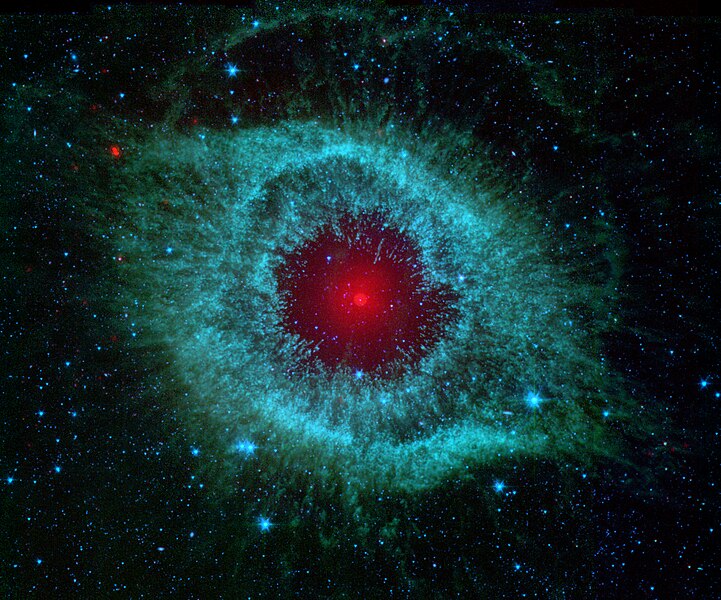Attēls:Comets Kick up Dust in Helix Nebula (PIA09178).jpg
Izskats

Šī priekšskata izmērs: 721 × 600 pikseļi. Citi izmēri: 289 × 240 pikseļi | 577 × 480 pikseļi | 923 × 768 pikseļi | 1 231 × 1 024 pikseļi | 2 462 × 2 048 pikseļi | 4 279 × 3 559 pikseļi.
Sākotnējais fails (4 279 × 3 559 pikseļi, faila izmērs: 7,22 MB, MIME tips: image/jpeg)
Faila hronoloģija
Uzklikšķini uz datums/laiks kolonnā esošās saites, lai apskatītos, kā šis fails izskatījās tad.
| Datums/Laiks | Attēls | Izmēri | Dalībnieks | Komentārs | |
|---|---|---|---|---|---|
| tagadējais | 2007. gada 13. februāris, plkst. 05.43 |  | 4 279 × 3 559 (7,22 MB) | Startaq | {{Information |Description=This infrared image from NASA's Spitzer Space Telescope shows the Helix nebula, a cosmic starlet often photographed by amateur astronomers for its vivid colors and eerie resemblance to a giant eye. The nebula, located about 700 |
Faila lietojums
Šo failu neizmanto nevienā lapā.
Globālais faila lietojums
Šīs Vikipēdijas izmanto šo failu:
- Izmantojums af.wikipedia.org
- Izmantojums ar.wikipedia.org
- Izmantojums arz.wikipedia.org
- Izmantojums ast.wikipedia.org
- Izmantojums ba.wikipedia.org
- Izmantojums bg.wikipedia.org
- Izmantojums bjn.wikipedia.org
- Izmantojums bn.wikipedia.org
- Izmantojums br.wikipedia.org
- Izmantojums ca.wikipedia.org
- Izmantojums cs.wikipedia.org
- Izmantojums de.wikipedia.org
- Izmantojums dsb.wikipedia.org
- Izmantojums en.wikipedia.org
- Helix Nebula
- Spitzer Space Telescope
- Comet nucleus
- Talk:Helix Nebula
- User:Swirlex/Userboxes
- User:Swirlex/Userboxcode
- NASA
- Wikipedia:Featured pictures/Space/Looking out
- User:Nonexyst
- User:Benjamin112
- Portal:Outer space/Selected picture
- User:Sunfishtommy/sandbox
- Wikipedia:Featured pictures thumbs/44
- Wikipedia:Featured picture candidates/October-2014
- User talk:Benison/Archive 19
- Wikipedia:Featured picture candidates/The God's Eye
- Wikipedia:Picture of the day/October 2016
- Template:POTD/2016-10-12
- Wikipedia:Main Page history/2016 October 12
- User talk:69.50.70.9
- User:The NMI User
- User:Corinne/subpage
- User talk:Benison/Archive 37
- Wikipedia:Userboxes/Science/Astronomy
- User:Catfurball
- User:Huggums537
Skatīt šī faila pilno globālo izmantojumu.




